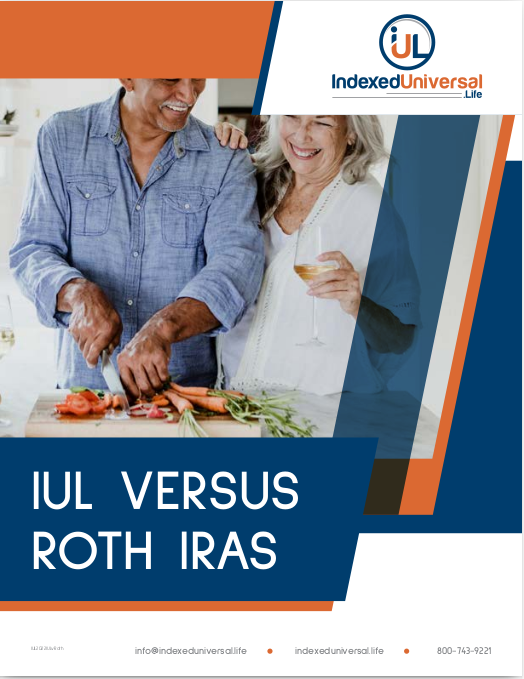
Key Takeaways:
- Indexed Universal Life (IUL) insurance offers greater flexibility in premium payments and potential for cash value growth, making it an appealing option for those seeking a dynamic financial tool.
- Traditional retirement plans provide consistent, predictable contributions and tax advantages, offering stability and long-term growth for retirement savings.
Indexed Universal Life vs. Traditional Retirement Plans: Which is More Flexible?
Choosing the right retirement plan is crucial for securing your financial future. While traditional retirement plans have long been the standard, Indexed Universal Life (IUL) insurance has emerged as a versatile alternative. This article explores the flexibility of IUL compared to traditional retirement plans, helping you determine which option aligns better with your financial goals and lifestyle.
Understanding Indexed Universal Life (IUL) Insurance
Indexed Universal Life insurance is a type of permanent life insurance that combines death benefit protection with a cash value component. The cash value grows based on the performance of a chosen stock market index, such as the S&P 500. Policyholders can allocate their premiums between the insurance and investment components, offering the potential for higher returns compared to traditional whole life insurance.
One of the standout features of IUL is its flexibility in premium payments. Policyholders have the option to adjust their premium payments within certain limits, allowing for financial maneuverability in times of need. This flexibility can be particularly advantageous for individuals whose income may fluctuate or who anticipate changes in their financial situation.
Traditional Retirement Plans: A Brief Overview
Traditional retirement plans, such as 401(k)s and Individual Retirement Accounts (IRAs), are well-established methods of saving for retirement. These plans offer tax advantages, such as tax-deferred growth or tax-free withdrawals in retirement, depending on the plan type. Contributions to traditional retirement plans are typically consistent and predictable, with employers often matching a portion of employee contributions in the case of 401(k) plans.
While traditional retirement plans provide a structured approach to saving, they lack the premium payment flexibility found in IUL policies. Contributions are usually fixed and must be made regularly, regardless of the individual’s financial situation. This predictability can be beneficial for disciplined savers but may pose challenges for those needing more adaptable financial strategies.
Flexibility in Contributions and Premiums
A significant aspect of flexibility in retirement planning is the ability to adjust contributions and premiums. IUL policies excel in this area by allowing policyholders to increase, decrease, or even skip premium payments within certain limits. This adaptability can help manage unexpected financial burdens or take advantage of periods of increased income.
In contrast, traditional retirement plans generally require regular, fixed contributions. While some plans offer provisions for hardship withdrawals or loans, these are typically limited and come with penalties or tax implications. The rigidity of contribution schedules can be a disadvantage for individuals whose financial circumstances change over time.
Investment Options and Growth Potential
Another key factor in evaluating the flexibility of retirement plans is the range of investment options and growth potential. IUL policies provide a unique opportunity for cash value growth tied to market performance. Policyholders can choose from various index options, potentially benefiting from higher returns during favorable market conditions. Additionally, most IUL policies include a cap and floor mechanism, ensuring that the cash value doesn’t decrease due to negative index performance.
Traditional retirement plans, while offering a variety of investment options such as stocks, bonds, and mutual funds, do not provide the same direct link to market indices as IUL policies. The growth potential in traditional plans is generally more predictable but may not reach the heights possible with an IUL policy. This predictability can be a double-edged sword, offering stability but potentially limiting upside growth.
Loan and Withdrawal Flexibility
The ability to access funds through loans or withdrawals is another crucial aspect of flexibility in retirement planning. IUL policies typically allow policyholders to borrow against the cash value of their policy with favorable terms. These loans are generally tax-free, and repayment terms can be flexible, providing a convenient source of funds when needed.
Traditional retirement plans, while also offering loan and withdrawal options, come with more stringent rules and potential penalties. For instance, early withdrawals from a 401(k) or IRA before the age of 59½ often incur a 10% penalty in addition to income taxes. Although some plans offer loan provisions, these loans must be repaid with interest, and failure to repay can result in taxes and penalties.
Tax Implications
Tax treatment is a critical consideration when comparing retirement plans. IUL policies offer tax-deferred growth on the cash value component, and the death benefit is typically paid out tax-free to beneficiaries. Additionally, policy loans are usually tax-free, providing a tax-advantaged source of funds.
Traditional retirement plans also offer tax advantages, with contributions often made on a pre-tax basis, reducing taxable income in the year of contribution. The investments grow tax-deferred, but withdrawals in retirement are subject to income tax. Roth IRAs offer tax-free withdrawals, but contributions are made with after-tax dollars. The choice between these tax treatments depends on individual financial goals and tax strategies.
Estate Planning and Legacy
When considering the flexibility of retirement plans, it’s essential to factor in estate planning and legacy goals. IUL policies can be an effective tool for estate planning, providing a tax-free death benefit to beneficiaries. This feature can help cover estate taxes, debts, or provide a financial legacy for loved ones.
Traditional retirement plans can also play a role in estate planning, but they come with different considerations. The tax treatment of inherited retirement accounts has changed with recent legislation, potentially leading to higher tax burdens for beneficiaries. It’s crucial to understand these implications and plan accordingly to maximize the legacy left to heirs.
Adjusting to Life Changes
Life is full of unexpected changes, and a flexible retirement plan can help navigate these shifts. IUL policies’ adjustable premiums, access to cash value through loans, and potential for higher returns provide a robust framework for adapting to life’s uncertainties. Whether facing a job loss, unexpected medical expenses, or other financial challenges, IUL policies offer tools to manage these situations effectively.
Traditional retirement plans, with their fixed contribution schedules and stricter withdrawal rules, may not provide the same level of adaptability. While they offer stability and predictability, they can be less responsive to sudden financial needs or changes in personal circumstances.
Tailoring to Individual Goals
Ultimately, the flexibility of a retirement plan should align with your individual financial goals and risk tolerance. IUL policies are well-suited for those who value adaptability and the potential for higher returns linked to market performance. They offer a combination of insurance protection and investment growth, making them a versatile financial tool.
Traditional retirement plans, on the other hand, are ideal for individuals seeking consistent contributions, tax advantages, and a structured approach to retirement savings. They provide a reliable foundation for long-term growth and security, appealing to those who prefer a more predictable financial strategy.
Navigating Financial Goals and Strategies
Both Indexed Universal Life (IUL) insurance and traditional retirement plans offer unique advantages and cater to different financial needs. IUL policies stand out for their premium payment flexibility, potential for higher returns, and favorable loan terms, making them a dynamic option for those seeking adaptability in their financial planning. Traditional retirement plans, with their consistent contributions, tax benefits, and structured savings approach, provide stability and long-term growth, appealing to those who prioritize predictability and discipline in their retirement strategy. By understanding the key differences and benefits of each, you can make an informed decision that aligns with your financial goals and life circumstances.





